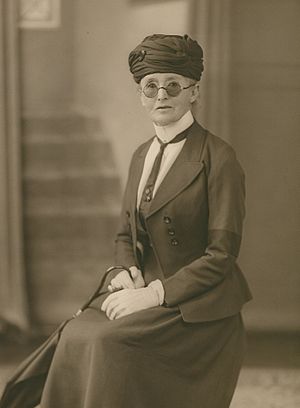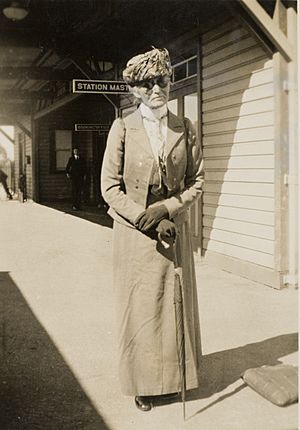Daisy Bates (author) facts for kids
Quick facts for kids
Daisy Bates
|
|
|---|---|
 |
|
| Born |
Margaret Dwyer
16 October 1859 Roscrea, Tipperary, Ireland
|
| Died | 18 April 1951 (aged 91) |
| Resting place | North Road Cemetery, Nailsworth, South Australia |
| Other names | Daisy May O'Dwyer, Daisy May Bates |
| Occupation | Journalist |
| Spouse(s) | Harry Harbord 'Breaker' Morant, John (Jack) Bates, Ernest C. Baglehole |
| Children | Arnold Hamilton Bates |
Daisy May Bates, CBE (born Margaret Dwyer; 16 October 1859 – 18 April 1951) was an Irish-Australian journalist and welfare worker. She spent her life studying Australian Aboriginal culture and society. Some Aboriginal people called Bates Kabbarli, which means "grandmother."
Contents
Early life in Ireland
Daisy Bates was born Margaret Dwyer in County Tipperary, Ireland, in 1859. At that time, Ireland was ruled by Britain. Her mother, Bridget, died when Daisy was three years old. Her father, James Edward O'Dwyer, died later while traveling to the United States. Daisy was raised by relatives in Roscrea and went to school there.
Moving to Australia
In November 1882, Margaret Dwyer changed her name to Daisy May. She moved to Australia on a ship called the RMS Almora. She said she left Ireland for health reasons.
Daisy first settled in Townsville, Queensland. She worked as a governess on a large farm called Fanning Downs Station.
She married a poet and horseman named Breaker Morant (Harry Morant) in March 1884. This marriage did not last long. She later married John (Jack) Bates in February 1885. Their son, Arnold Hamilton Bates, was born in August 1886 in Bathurst, New South Wales. Daisy also married Ernest Baglehole in June 1885. She had met him on her journey to Australia.
The marriage with Jack Bates was not easy because his work kept him away from home often.
In 1894, Daisy Bates went back to England. She sent her son Arnold to a Catholic boarding school. She worked for a journalist and social campaigner named WT Stead. She became interested in intellectual life in London.
In 1899, she returned to Western Australia. She had read a letter in The Times newspaper about how settlers were treating Aboriginal people. She offered to investigate these claims and report back to the newspaper. Her offer was accepted.
Working with Aboriginal people
Daisy Bates became very interested in the cultures of Aboriginal Australians. She spent 40 years of her life studying their way of life, history, culture, and beliefs. She lived in a tent in small settlements, from Western Australia to the Nullarbor Plain, including a place called Ooldea in South Australia.
She was known for always wearing Edwardian clothes, even in the bush. This included boots, gloves, and a veil.
Bates set up camps to help Aboriginal people. She gave them food, clothes, and nursing care. She used her own money to help the elderly.
She believed that Aboriginal people were a "dying race" because of the impact of European settlement. She thought it was her job to record as much as she could about them before their cultures disappeared.
In Western Australia
When she returned to Australia, Daisy Bates met Father Dean Martelli, a Roman Catholic priest who worked with Aboriginal people. He helped her understand the challenges they faced. She found a school for her son in Perth and bought some property for her future. Then, she traveled to the remote north-west of Western Australia to learn about Aboriginal people and the effects of white settlement.
She wrote articles about the conditions around Port Hedland for journals and newspapers, including The Times. She became very dedicated to the lives and well-being of Aboriginal people in Western and South Australia.
At the Beagle Bay Mission near Broome, Bates began her life's work. Her writings were some of the first serious studies of Aboriginal culture. They were published in journals and by anthropological and geographical societies.
While at the mission, she created a dictionary of several local dialects. It had about two thousand words and sentences, along with notes on legends and myths. In 1902, Bates, her son, and her husband went on a long trip from Broome to Perth. This journey gave her good material for her articles. After traveling four thousand kilometers, she knew her marriage to Jack Bates was over.
After separating from Jack in 1902, she spent most of her life in the outback of Western and South Australia. She studied and worked with remote Aboriginal tribes. These groups were facing many difficulties due to European settlement and new diseases.
In 1904, the Registrar General of Western Australia asked her to research Aboriginal customs, languages, and dialects. She worked on this project for almost seven years, collecting and organizing information. Many of her papers were read at meetings of geographical and Royal Society groups.
From 1910 to 1911, she joined an expedition to study marriage customs in Western Australia. She was named a "Travelling Protector" of the Aborigines. Her job was to look into all conditions and problems faced by native people, such as their employment and living situations.
A "Protector of Aborigines"
In 1912, Daisy Bates applied to become the Protector of Aborigines for the Northern Territory. However, she was rejected because she was a woman. She continued her work on her own, using money from selling her cattle station.
That same year, she became the first woman to be an Honorary Protector of Aborigines at Eucla. She spent sixteen months there. During this time, she became a strong friend and protector of Aboriginal people. She decided to live among them to care for them and to record their lives.
Bates stayed at Eucla until 1914. Then, she traveled to Adelaide, Melbourne, and Sydney to attend a Science Congress. Before returning to the desert, she gave talks in Adelaide that interested several women's groups.
During her years at Ooldea, she bought supplies for the Aboriginal people by selling her property. To earn more money, she wrote many articles and papers for newspapers, magazines, and learned societies. Her work became known to the public through journalist and author Ernestine Hill.
In August 1933, the Australian Government invited Bates to Canberra to give advice on Aboriginal affairs. The next year, King George V made her a Commander of the Order of the British Empire. Bates was happy about this honor because it helped her get her work published.
In South Australia
She left Ooldea and moved to Adelaide. With help from Ernestine Hill, Bates published a series of articles in major Australian newspapers called My Natives and I. Even at 71 years old, she walked every day to her office at The Advertiser building.
Later, the Australian Government paid her a small amount each week to help her organize her papers and prepare her planned book. But it was too expensive to stay in Adelaide. She moved to a village called Pyap on the Murray River. There, she set up her tent and typewriter.
In 1938, she published her book The Passing of the Aborigines, which became very well known.
Final years
In 1941, Bates returned to living in her tent at Wynbring Siding, east of Ooldea. She lived there on and off until 1945, when she went back to Adelaide because of her health.
In 1948, she tried to contact her son, Arnold Bates, who had served in France during World War I. She tried again in 1949. Arnold was living in New Zealand, but he did not want to have contact with his mother.
Daisy Bates died on 18 April 1951, when she was 91 years old. She is buried at Adelaide's North Road Cemetery.
Recognition and memberships
- Bates was chosen as a member of the Royal Geographical Society (Melbourne).
- In 1907, she became a Fellow of the Royal Anthropological Society of Australasia (F.R.A.S.).
- She was made an honorary corresponding member of the Royal Anthropological Institute of Great Britain and Ireland.
- In 1934, she received the CBE honor.
Digital database
There is an online project by the National Library of Australia and the University of Melbourne. They are working to make digital copies of many word lists that Bates created in the 1900s. This project is led by Nick Thieburger. It aims to digitize all the microfilmed images from Section XII of Bates's papers. This will be a valuable resource for people studying languages from Western Australia, and some from the Northern Territory and South Australia.



